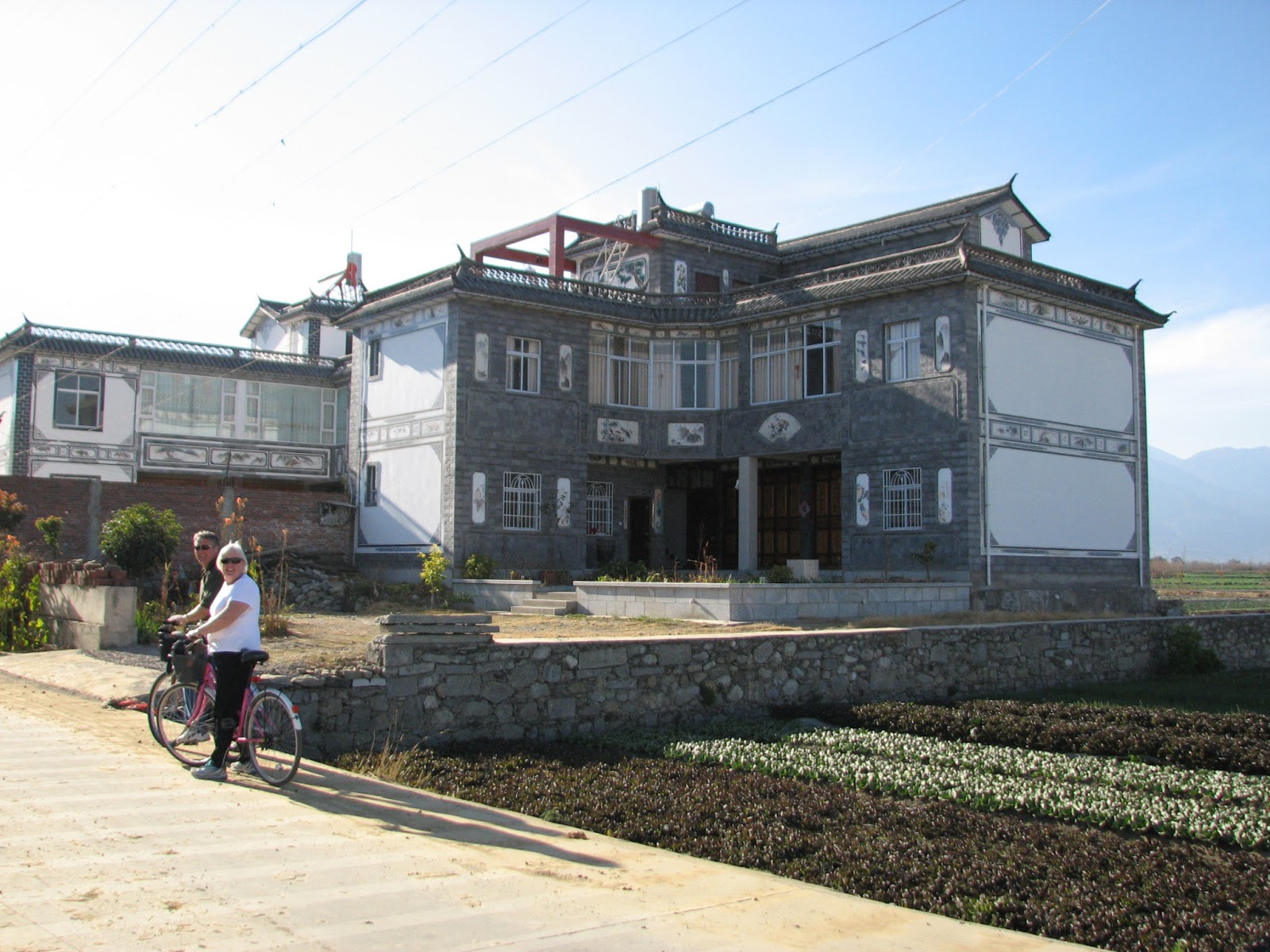 |
| Wind Farm - Chinese characters on the side of the hill |
 |
| Farmers busy working |
The performance was staged in a beautiful, big courtyard home that was owned by a wealthy Chinese man who made his fortune in marble. There are marble quarries in Dali and the beautiful marble is made into lovely art as well as building material. The home had some marble accents which were so pretty.
 |
| No, it's not a mountain or ocean painting, it's marble! |
 |
 |
| Courtyard entrance--isn't it fabulous? |
 |
| More lovely art--3D! |
 |
| Our hotel lobby--gorgeous! |
 |
| Reception |
 |
| The hallway and door to our room |
We went to a park across the street where the camellias are in bloom. They are about 3 times as big as those my Dad grew.
The park was not in the best state--people had carved graffiti into the agave leaves, and we saw rats running around the mahjong tea rooms, but the water was pretty.
 |
| My reflection in the water under the bridge. |
 |
| Dining choices along the street. It included several insects! |
 |
| Chinese barber 'pole'--it spins around |
 | ||
| The West Gate of the old city wall. |
 |
| Local native dress |
 |
| Juying Chi, a second reflecting pool in back, gives another beautiful photo op. |
 |
| Leaning tower |
 |
 |
| Love the Chinese translations and spelling-- "Racy Clable" on your left. |
 |
| Another common temple site--dragons carved in a slanted stone slab in front. |
 |
| Happy, smiling golden Buddha |
 |
| More austere-looking Buddha |
 |
| Pretty koi ponds on the grounds |
This large golden "spike" is called The Vajra, or devil-surrendering stamper. It is made of copper and plated with gold and this is the largest one in China.
We found Magnum Bars in the snack stands here, so this tourist stop rates 5 stars!
We went to visit a marble salesroom with beautiful vases, sculptures and other object d'art. I bought a rolling pin! I got a kick out of the delivery cart driving right into the store with all the displays. Only in China!
 |
| Marble on display |
 |
| Kirk got a kick out of this salesclerk with the Stanford sweatshirt! |
 |
| Look out! |
 |
| Unsupervised minors setting off fireworks! |
 |
| They really do use these balancing baskets. (Notice the cute trash can.) |
 |
| Darling little baby helping her Mom sell New Year's decorations--the Year of the Snake. |
 |
| Pavilion on the lake |
 |
| Woman washing her vegetables |
 |
| The only "man" we saw working in Yunnan! |
 |
| Construction workers--all women |
 |
| I might actually eat a fish caught in this lake--it was relatively clean. |
We particularly enjoyed riding through the fields and watching the people farming and working. It was very refreshing and interesting.
 |
| Farm home in the countryside. |
 |
| Think YOU work hard? |
 |
| She is hand watering each plant. |
I remember when this bronze was unearthed in 1969--from the Han Dynasty. It intrigued me then, and I got to see the original in the US. Here is a replica, still considered a prime example of great Chinese sculpture and form.
 |
| 'Bronze galloping horse treading on a flying swallow' |
This pagoda southwest of old town looks very much like Qianxun, but it was in a "park" that was locked up. The tower had greenery growing from the roof. Apparently it doesn't get the same attention as the 3 Pagodas down the street.
Back at the South Gate, there were costumed Bai people in front taking pictures. The one in red is the legendary "Monkey King" that I mentioned earlier.
 |
| South Gate |
 |
| Honglongjing (Red Dragon Well), a spring coming up and flowing into old town. |
 |
| Courtyard homes in old town |
 |
| Not sure what this was for..... A leather Halloween costume? |
 |
| The bottom of Honglongjing as it flows into old town. |
 |
| South Gate from the inside |
 |
| View south from the city wall |
 |
| Hiking on the city wall |
 |
| View of old town |
 |
| The lights are on--see the holes in the sidewalk? That's the creek running through town. |
 |
| Yangbi River in new town Dali |
Next stop: Kunming, China























No comments:
Post a Comment